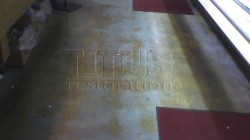- Acid Stain Walk-Off
- Acid Stain Close Up
In this article we will talk about the do’s and don’ts of acid stain and polished concrete:
- Decorative Concrete
- Acid Staining Concrete is Not for Everyone
- Beginning to Understand Acid Stains
- Acid Staining New Concrete – Avoid the Major Problems
- Acid Staining Old or Existing Concrete
- When to Use Acid Stain vs. When to Dye and Polished the Concrete
- The Sealer is the Key to Durability
- In Conclusion Acid Stained and Sealed Concrete vs. Dyed and Polished Concrete
Decorative Concrete
Decorative concrete is truly flourishing and seems to be here to stay. Millions of feet of acid staining are done a year and most people (even in the industry) don’t understand the process. They recommend “sample” and “test.” I hope this article does better than that for you. Acid staining concrete has a place in decorative concrete…that is if the industry is not ruined by misunderstanding the product and what is required of the concrete substrate so it will accept acid stain properly. As with all social transitions or advances in technology, there is some catching up to do as the new transition or technology is adopted by a wider segment of the population. Green and sustainable architecture is being widely adapted.
Things Change – Usually as the Result of Failure
Since 1972 I have been involved in chemical coatings (the industrial term for painting). A couple of decades ago, we used inexpensive block fillers made with calcium carbonate and top coated them with epoxies. Eventually technology gave way to block fillers made more like paint itself…but this did not happen until hundreds of thousands of square feet failed. The high humidity of showers and bath houses drew moisture through the epoxy into the block filler by the dry cement block. When this happened, the inexpensive block fillers re-emulsified like drywall mud and the epoxy coatings failed. Other times cheap fillers sheared when high build epoxies were applied on top of them.
A similar fate was in store for acid etching of concrete floors when high build epoxies literally sheared the concrete surface. When failure analysis revealed concrete on the back side of the paint chip, industry standards turned to steel shot blasting to create a profile for high build coatings and banned acid etching as an acceptable form of surface preparation as it weakened the surface of the concrete.
Acid Staining Concrete is Not for Everyone
This article is meant to address only one aspect of decorative concrete – acid staining concrete floors with reactive acid stains. There is no shortage of beautiful pictures of acid stained floors in magazines or on the internet. Nor is there a shortage of books, paid training classes, or “how-to” CD’s on acid stain. Neither is there any shortage of people hopping on the band wagon and claiming expertise. In reality, a floor that readily accepts acid stains is dependent upon a properly poured and properly cured concrete slab. As you will read below, I am not so sure that is practical.
My concern for acid stains in particular is that they are now available at the local paint stores. Everyone wants to do a DIY acid stain project. Maybe acid stains should only be sold only by establishments that sell concrete curing compounds or specialty concrete coatings instead. Based on my background in coatings for commercial and industrial environments, I am quite convinced that neither the concrete contractor, the local paint store, nor the American consumer is properly prepared or properly equipped to use these products.
There is no need to tell customers how uniquely beautiful an acid stained concrete floor can be. There are plenty of people out there doing that. I am therefore taking on the task of concrete coating expert…not decorative concrete artisan. If a beautiful, smooth, cleanable floor finish is desired, acid staining your concrete could be an excellent choice…or a catastrophe.
There is no need to tell customers how uniquely beautiful an acid stained concrete floor can be. There are plenty of people out there doing that. I am therefore taking on the task of concrete coating expert…not decorative concrete artisan. If a beautiful, smooth, cleanable floor finish is desired, acid staining your concrete could be an excellent choice…or a catastrophe. The reason I am writing this article is that unfortunately, many people are getting unsatisfactory results…and this is from those who claim to be professionals. I am, therefore, even more concerned when reactive acid stains enter the “retail” market and these products are used by home owners. This article will attempt to help non-technical persons understand the how, when, and where of acid stained concrete…and how to get the desired end product.
Beginning to Understand Acid Stains
Acid stains contain a mild acid, typically hydrochloric acid, to open pores of the concrete slab so the metallic salts of the stain can react with the free lime in the cement paste and a chemical reaction in the concrete produces the color variation typical of acid stains. Reactive acid stains are limited to tans/ browns, greens, and reddish browns. They etch the concrete by eating away the free lime between the sand particles. This etching is both a blessing and a curse. This etching must be understood and properly considered when specifying acid stains. But first, it is important to understand the role that the concrete itself plays in the success of an acid stain project. Since both new concrete and old concrete are candidates for acid staining we will address both.
If you do not like the result…you CANNOT just put down more acid stain! The free lime in the top surface of your concrete is gone. You would have to grind the floor to expose all fresh concrete…and by the time you ground the floor that deeply…th aggregate (rocks) in your concrete would probably begin to show. So, basicly, you have one shot at acid staining.
Acid Staining New Concrete – Avoid the Major Problems
Acid stains contain a mild acid, typically hydrochloric acid, to open pores of the concrete slab so the metallic salts of the stain can react with the free lime in the cement paste and a chemical reaction in the concrete produces the color variation typical of acid stains. Reactive acid stains are limited to tans/ browns, greens, and reddish browns. They etch the concrete by eating away the free lime between the sand particles. This etching is both a blessing and a curse. This etching must be understood and properly considered when specifying acid stains. But first, it is important to understand the role that the concrete itself plays in the success of an acid stain project. Since both new concrete and old concrete are candidates for acid staining we will address both. Good acid staining begins with proper curing of the wet concrete. New concrete needs moisture to cure. Wet curing concrete makes the concrete stronger. Almost every concrete professional will agree with this. But wet curing is especially important if one is going to acid stain concrete. No membranes are added to the top of the concrete that will inhibit the penetration and reaction of the acid with the free lime.
Unfortunately, most concrete contractors do not wet cure concrete as it is more costly. The alternative to wet curing is to use a concrete curing agent. It is inappropriate (like calling a refrigerator a “Frigidaire”), but concrete curing compounds are typically called “cure-n-seals.” But not all ASTM 309 curing agents cure AND seal the concrete. There are those that just cure the concrete. These concrete curing agents typically act to keep the moisture in the concrete long enough to cure it or they also act to seal the concrete. Technically, the latter are called “cure and seal” compounds.
Neither curing compounds or cure and seal products work well with acid stains. Almost all the curing compounds that have no sealing capabilities require sunlight to dissipate and, in our experience, most curing membranes exist long after the building is built. This is one area in which I fear the consumer may be unprepared in dealing with acid stains.
It is important to understand that acid stains react with concrete paste, but just not any old concrete paste, acid stains react with calcium hydroxide (herein after referred to as “free lime”). This is the softer concrete paste. Over time, most of concrete’s free lime turns to a harder substance called calcium silicate hydrate. I had a mineralogist tell me that calcium silicate hydrate (herein after referred to as CSH) is what concrete paste wants to be when it grows up. The bulk of the conversion of free lime to CSH takes place within 28 days of placement of the concrete, but the balance of free lime will slowly covert to CHS over the years. This is the reason the surface of some older concrete slabs do not accept acid stain well.
Acid Staining Old or Existing Concrete
Most acid staining is performed on concrete floors that are already in place, therefore, it is very likely that no one will know the history of the concrete slab installation or what methods and materials were used to cure the concrete floor slab. In this case, Titus recommends grinding the slab prior to acid staining. The floor must be ground deep enough to remove all the curing compounds but hopefully not so deep as to expose excessive aggregate. We think floors with more paste and trowel swirls take acid stain better than floor ground to salt and pepper (sand exposure) or exposed aggregate. The problem is that it is difficult if not impossible to tell when all the curing compounds are out of the concrete – especially if they are out of the dips or low spots in the concrete slab. Most floor grinding machines tend to pass over these “bird baths” as we call them. If all curing compounds (or oils, etc) are not removed from the concrete, those spots will accept the acid stain differently. Sometimes these will show up as white or yellow spots.
We are in the business professionally and we always grind every slab we acid stain very thoroughly but sometimes we still miss removing spots of curing compound and have to spot grind or re-grind and re-stain the floor. One customer told us that they had 50,000 square feet of concrete acid stain that had this unacceptable spotting. Whose fault is it? The architect who specified the methods and material for the concrete installation and acid staining? The concrete finisher? The acid stain applicator? Without placing blame, just let me say that I am of the opinion that reactive acids stains are falling prey to misuse.
When to Use Acid Stain vs. When to Dye and Polished the Concrete
Remember that acid stains etch (eat away the cement paste) the top surface of the concrete slab. Something needs to fill those voids so the concrete does not crumble under foot and the color walk off. Material suppliers are getting better at understanding this, but many are still specifying a top coat that is 20% solids that is applied at 300-500 square feet per gallon. This is not a good thing. Based on my industrial coating background, that tells me (mathematically) that at 10% loss factor and 400 square feet per gallon, only .75 mils DFT (dry film thickness) are being applied to the floor. A sheet of typing paper is 4 mils – ; See Acetone Dye and Urethane.
The Sealer is the Key to Durability
I do not consider cure and seals or low solid sealers adequate protection for acid stained concrete. Especially for an etched colored floor that people will be walking on with dirty and sandy shoes. For me, acids stains require more coating thickness, and preferably tougher coatings. Titus recommends a two component urethane that has around 50% solids. We suggest multiple coats (minimum of 2) plus multiple coats of a sacrificial wax (minimum of 3). We believe that to properly seal an acid stain, one must apply enough of a low viscosity sealer with a high solids content that will cure to be very hard. This will serve to fill the pores created by acid etching and prevent color walk off and it will also seal the concrete against most food and oil stains – even acidic food stains left on the floor for long periods of time (citric acid, vinegar, the phosphoric acid in soft drinks, pickle juice, ketchup, etc.).
Polished Concrete Has Some Advantages
Acetone dyes put into polished concrete are more color uniform than acid stains, but to me, their main advantage is that they are literally “in” the concrete – not residing in acid weakened cement paste. The dyes penetrate the cement paste down to and around the sand particles of a concrete floor that has been honed with industrial diamonds. Densifiers are then applied on top of the dyes…so before the color walks off, the hardened and polished concrete and sand particles will have to walk off.
In Conclusion Acid Stained and Sealed Concrete vs. Dyed and Polished Concrete
This is a very easy choice when you know how each type of decorative concrete works. Here are the primary systems:
- If I need chemical or food resistance with low or moderate traffic (such as a restaurant), my vote is for acid stain with a top of the line two component polyurethane sealer. I would use a solvent based sealer for the best protection, water based if I am unsure of the moisture vapor transmission rate of the concrete slab.
- If I have the same chemical resistance requirements and want colored concrete in a high traffic area, I would hone the concrete with diamonds, apply an acetone dye, and multiple so the sealer most people are putting over acid stained floors is about 1/5th the thickness of a sheet of typing paper. coats of a two component sealer. Again, solvent based for the best protection, water based if I am unsure of the moisture vapor transmission rate of the concrete slab.
- If I have very high traffic (a school, commercial or retail store, auto service area), if I have an uncertain moisture vapor transmission rate, a high need for low maintenance, or very rugged wear (but very little need for acid or harsh chemical resistance), my choice hands down is polished concrete.


